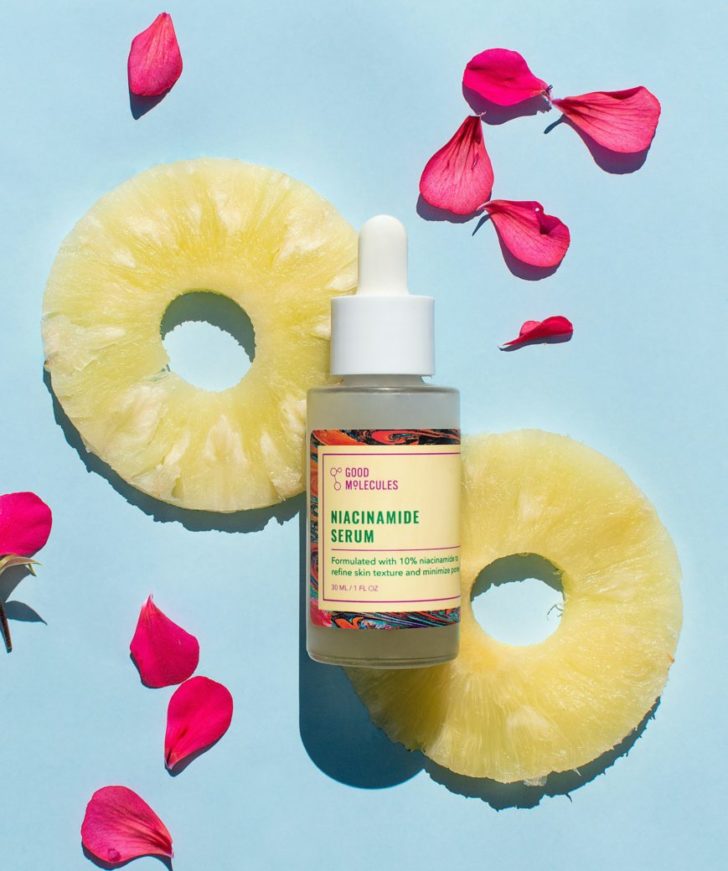Imagine having a single skincare ingredient that could tackle a wide range of skin concerns, from uneven tone and texture to acne and inflammation. Enter Niacinamde, a form of Vitamin B3 that has been making waves in the skincare world for its impressive range of benefits. In this blog post, we’ll explore the science behind the power of niacinamide, how it works in different forms, and how you can integrate niacinamide into your skincare routine to achieve a healthier, more radiant complexion. Let’s dive in!
Table of Contents
Short Summary
Niacinamide is a powerful skincare ingredient that improves skin tone and texture, strengthens the skin barrier, reduces acne and inflammation.
When applying niacinamide to sensitive or mature skin, use gentle products with caution for best results.
Look for high-quality niacinamide products with suitable concentrations (5%-10%) to ensure effectiveness and safety. Visible results may take 2, 4 weeks of twice daily application.
The Power of Niacinamide: A Comprehensive Overview

Niacinamide, also known as nicotinamide, is a form of Vitamin B3 that has been gaining popularity in skincare products due to its numerous benefits for skin health. It is suitable for sensitive skin and can help brighten, fortify, and decrease inflammation, making it a valuable addition to any skincare routine. With its increasing use in clinical practice, it’s no surprise that many people are starting to take notice of this powerful ingredient.
To fully harness the power of niacinamide, it’s essential to understand the differences between topical and oral forms, as well as its distinction from nicotinic acid. In this section, we’ll explore these differences and explain why niacinamide is preferred over nicotinic acid for skincare purposes.
Topical Niacinamide vs. Oral Nicotinamide
Topical niacinamide, also known as topical nicotinamide, is used for skin health, while oral nicotinamide is primarily for deficiency treatment and requires medical supervision. When applied directly to the skin, topical niacinamide has been shown to have positive effects on various skin concerns, leading some dermatologists to believe that it may be more effective than oral nicotinamide in addressing these issues.
However, it’s important to note that oral niacinamide can sometimes cause adverse effects such as diarrhea, nausea, and vomiting.
In summary, while both topical and oral niacinamide have been utilized to treat inflammatory skin conditions and offer benefits for the skin, topical niacinamide is the preferred choice for skin health as it poses fewer potential side effects and allows for targeted application.
Niacinamide vs. Nicotinic Acid
Although niacinamide and nicotinic acid are both derivatives of vitamin B3, they possess distinct properties and advantages. Niacinamide is the amide form of B3, which is different from niacin, a form that can cause flushing and irritation. This makes niacinamide the preferred choice for skincare, as it is generally better tolerated by the skin and offers a range of benefits without the risk of unwanted side effects.
So when it comes to skincare, niacinamide is the clear winner over nicotinic acid. By choosing products containing niacinamide, you can enjoy its numerous skin benefits without the risk of irritation or flushing associated with nicotinic acid.
Unlocking Niacinamide’s Skin Benefits

Niacinamide’s versatility truly shines when it comes to the variety of skin benefits it offers. This powerful ingredient can improve skin tone and skin texture, strengthen the skin barrier, and reduce acne and inflammation.
Let’s delve deeper into these benefits and discover how niacinamide can transform your skin.
Improving Skin Tone and Texture
One of the most notable benefits of niacinamide is its ability to help reduce hyperpigmentation. It works by inhibiting the transfer of melanin from melanocytes to keratinocytes, aiding in the evenness of skin tone and reducing the visibility of dark spots. With regular use, niacinamide can help you achieve a brighter and more even complexion.
Niacinamide also plays a significant role in reducing the appearance of fine lines and wrinkles, as well as preventing premature skin aging. By stimulating collagen production and increasing skin elasticity, niacinamide helps to smooth out these signs of skin aging and maintain a youthful appearance. In addition, its anti-inflammatory properties may prevent the formation of wrinkles by reducing inflammation in the skin.
Strengthening Skin Barrier Function
A strong skin barrier is essential for maintaining healthy, hydrated skin. Niacinamide reinforces the skin barrier by increasing the production of ceramides, lipid molecules that form a protective layer on the skin. This helps to retain moisture and protect against environmental damage, such as pollution and UV radiation.
By promoting the production of natural moisturizing factors (NMFs) in the skin, niacinamide also helps to reduce water loss and keep the skin hydrated. This is particularly beneficial for those with dry or mature skin, as it helps to maintain optimal skin hydration and prevent the signs of premature aging.
Additionally, niacinamide has been shown to increase the production of antioxidants in the skin, which can help neutralize free radicals and protect against damage that can lead to premature aging. By strengthening the skin barrier, niacinamide not only helps to retain moisture, but also guards against the harmful effects of environmental stressors.
Treating Acne and Reducing Inflammation
Niacinamide’s anti-inflammatory properties make it an effective treatment to treat acne and other inflammatory skin conditions. By reducing sebum production, niacinamide can help to decrease acne breakouts, as well as minimize the appearance of oily skin and reduce the risk of clogged pores. Additionally, it has been shown to reduce inflammation, resulting in reduced redness and irritation. Another common acne treatment is benzoyl peroxide, which also targets acne-causing bacteria and reduces inflammation.
Studies have also demonstrated that niacinamide can be beneficial in reducing papules and pustules associated with inflammatory acne, as well as improving the appearance of acne scars. Its anti-inflammatory properties make it a valuable addition to any skincare routine, particularly for those who suffer from acne or other inflammatory skin conditions.
Learn more about Niacinamide’s Skin Benefits?, visit What benefits does niacinamide offer.
Integrating Niacinamide into Your Skincare Routine
Now that we’ve explored the many benefits of niacinamide, let’s discuss how to incorporate this powerful ingredient into your skincare routine. In this section, we’ll provide guidance on combining niacinamide with other ingredients and offer tips for application, particularly for those with sensitive or mature skin.
When using niacinamide, it’s important to be mindful of the other ingredients.
Combining Niacinamide with Other Ingredients
Niacinamide is highly compatible with other active ingredients, providing enhanced skin benefits when used in combination. For instance, when addressing pigmentation concerns, niacinamide can be combined with hydroquinone, kojic acid, arbutin, or soy for more effective results. Additionally, niacinamide is compatible with stable and powerful antioxidants, such as camellia sinensis (green tea), catechins, quercetin, and tocopherol. By combining niacinamide with these other active ingredients, you can maximize its skin benefits and achieve a more comprehensive approach to your skincare routine.
However, it’s important to be cautious when combining niacinamide with other active ingredients, as this may result in an increased risk of irritation. Always conduct a patch test before using any new product and consult your dermatologist if you have any concerns.
Application Tips for Sensitive and Mature Skin
For those with sensitive or mature skin, it’s important to take a cautious approach when incorporating niacinamide into your skincare routine. Start with a low concentration of niacinamide and gradually increase as your skin becomes more tolerant. This helps to minimize the risk of irritation and allows your skin to adjust to the new ingredient.
When applying niacinamide, be sure to use a gentle cleanser and moisturizer, and avoid using multiple products simultaneously. This can help reduce the chance of irritation and ensure that your skin receives the maximum benefits of niacinamide without any adverse effects.
Finally, be patient and consistent with your niacinamide usage. It typically takes 2-4 weeks to see visible results, but ongoing use is necessary to maintain its benefits. With patience and consistency, you’ll be well on your way to achieving a healthier, more radiant complexion.
Addressing Potential Side Effects and Precautions
As with any skincare ingredient, it’s important to be aware of potential side effects and precautions when using niacinamide. When niacinamide is taken orally or applied directly to the skin, some people might experience reddening of their skin. This is known as “flushing”.
In this section, we’ll provide guidance on how to recognize signs of irritation and choose high-quality niacinamide products to minimize potential side effects.
Recognizing Signs of Irritation
Irritation is a broad term for a skin reaction to a product or ingredient, while dermatitis is a form of skin inflammation. In cases of irritation, one may experience skin redness, itching, burning, stinging, or atopic dry skin. If you notice any of these signs, it’s important to monitor your skin for any adverse reactions and consult your dermatologist if necessary.
By being mindful of potential irritation and dermatitis, you can ensure the safe and effective use of niacinamide in your skincare routine. Always pay close attention to your skin’s response to any new product, and don’t hesitate to seek professional advice if you have any concerns.
Choosing High-Quality Niacinamide Products
Selecting high-quality niacinamide products is crucial for minimizing potential side effects and ensuring the best results for your skin. When choosing a product, look for those with a higher concentration of niacinamide, typically between 5-10%, and use a high-quality, pharmaceutical-grade niacinamide.
Additionally, consider the formulation of the product and whether it is suitable for your skin type and concerns as part of your skin care routine. Research and reviews should also be consulted to ensure its effectiveness and safety, as well as to check that the product adheres to industry standards, such as the “Kligman standards” of cosmeceutical-ingredient analysis.
Realistic Expectations: How Long Does It Take to See Results?
Although niacinamide offers numerous benefits for the skin, it’s important to have realistic expectations when it comes to visible results. Generally, it takes 2-4 weeks of twice daily application to see improvements in your skin’s appearance. However, results can vary between individuals, and ongoing use is necessary to maintain the benefits of niacinamide.
Patience and consistency are key when using niacinamide. By sticking to a regular skincare routine and giving your skin time to adjust to the new ingredient, you can achieve a healthier, more radiant complexion that reflects the powerful benefits of this versatile ingredient.
Summary
In conclusion, niacinamide is a powerful skincare ingredient that offers a wide range of benefits for the skin, including brightening, strengthening, and reducing inflammation. By understanding the differences between topical and oral forms, as well as its distinction from nicotinic acid, you can make informed decisions about incorporating niacinamide into your skincare routine.
Whether you’re looking to improve your skin tone and texture, strengthen your skin barrier, or treat acne and inflammation, niacinamide is a versatile and effective ingredient that can help you achieve a healthier, more radiant complexion. So why not give it a try and unlock the power of niacinamide for yourself?
Frequently Asked Questions
What niacinamide does for skin?
Niacinamide can help soothe skin inflammation and redness, as well as providing relief from irritation caused by harsh exfoliants. It’s an ideal choice for those dealing with conditions such as acne, rosacea and eczema.
Is niacinamide OK to use everyday?
Yes, it is safe to use niacinamide everyday. Its antioxidant properties can combat any signs of damage during the day and help repair your skin throughout the evening.
This powerful ingredient can be found in a number of moisturizing skin-care products as well as certain foods and supplements like multivitamins.
What does niacinamide do to acne?
Niacinamide reduces acne inflammation and regulates oil production, making it a beneficial solution for treating breakouts.
What is better hyaluronic acid or niacinamide?
For those looking to address acne, inflammation or excess oil production, niacinamide is the better choice.
For those struggling with dryness, dehydration or aging skin, hyaluronic acid is a more suitable option.
Can niacinamide be used with other active ingredients?
Niacinamide can indeed be used with other active ingredients such as hydroquinone, kojic acid, arbutin, soy, peptides, and antioxidants, giving your skin even more benefits when used together.









